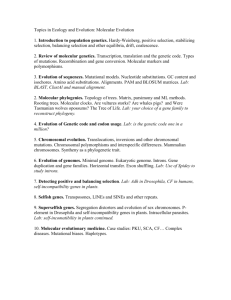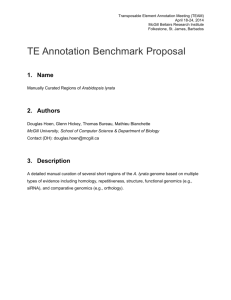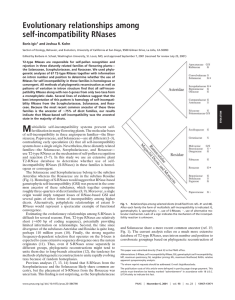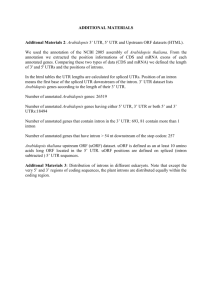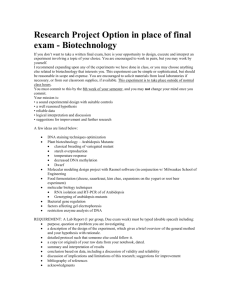Evolution of self-incompatibility: Early Views: Whitehouse (1950):
advertisement
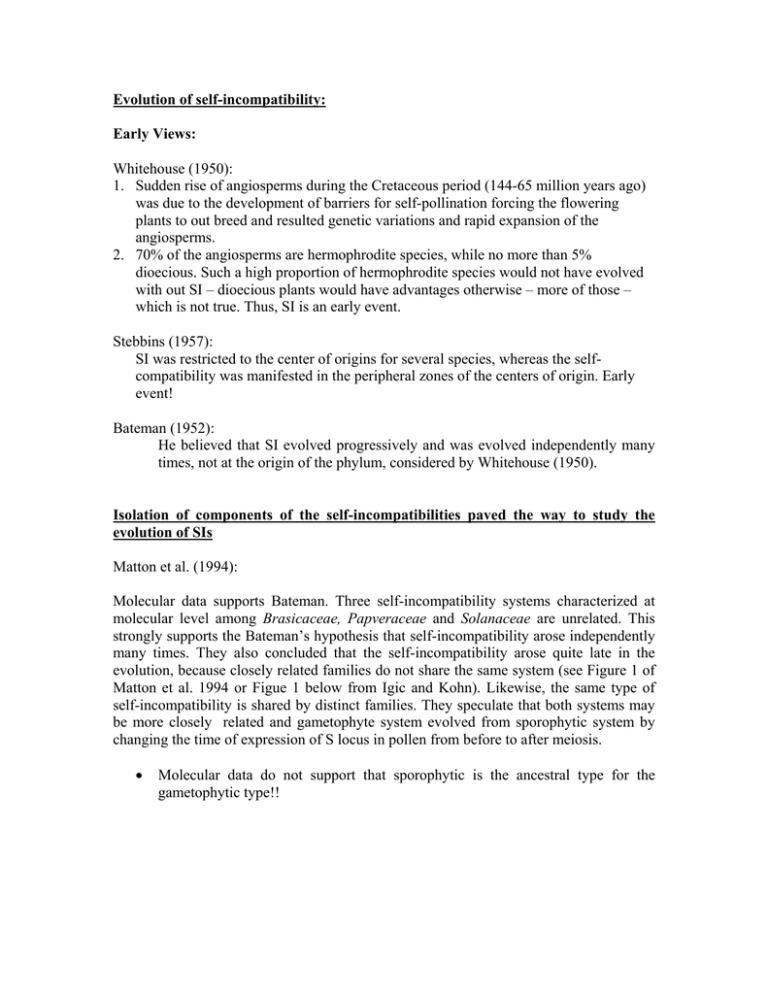
Evolution of self-incompatibility: Early Views: Whitehouse (1950): 1. Sudden rise of angiosperms during the Cretaceous period (144-65 million years ago) was due to the development of barriers for self-pollination forcing the flowering plants to out breed and resulted genetic variations and rapid expansion of the angiosperms. 2. 70% of the angiosperms are hermophrodite species, while no more than 5% dioecious. Such a high proportion of hermophrodite species would not have evolved with out SI – dioecious plants would have advantages otherwise – more of those – which is not true. Thus, SI is an early event. Stebbins (1957): SI was restricted to the center of origins for several species, whereas the selfcompatibility was manifested in the peripheral zones of the centers of origin. Early event! Bateman (1952): He believed that SI evolved progressively and was evolved independently many times, not at the origin of the phylum, considered by Whitehouse (1950). Isolation of components of the self-incompatibilities paved the way to study the evolution of SIs Matton et al. (1994): Molecular data supports Bateman. Three self-incompatibility systems characterized at molecular level among Brasicaceae, Papveraceae and Solanaceae are unrelated. This strongly supports the Bateman’s hypothesis that self-incompatibility arose independently many times. They also concluded that the self-incompatibility arose quite late in the evolution, because closely related families do not share the same system (see Figure 1 of Matton et al. 1994 or Figue 1 below from Igic and Kohn). Likewise, the same type of self-incompatibility is shared by distinct families. They speculate that both systems may be more closely related and gametophyte system evolved from sporophytic system by changing the time of expression of S locus in pollen from before to after meiosis. • Molecular data do not support that sporophytic is the ancestral type for the gametophytic type!! Self-incompatibility – Evolution 2 Igic and Kohn( 2001): On the contrary, Igic and Kohn came to a different conclusion from the phylogenetic analysis of 67 T2-type RNases from different plant species. Their data suggest that selfincompatibility-specific T2-type RNases, responsible for self-pollen recognition and rejection, and similar T2-type RNAses with no pollen rejection functions were evolved from a common ancestor. They interpreted that RNase-based self-incompatibility was the ancestral state in the majority of dicots. Fig. 1. Relationships among selected dicots (modified from refs. 41 and 46). After each family the form of multiallelic self-incompatibility is indicated: G, gametophytic; S, sporophytic; +, use of S-RNases; , use of alternative molecular mechanism. Lack of a sign indicates the mechanism of the incompatibility reaction is unknown (from: Igic and Kohn 2001). 1. They compare sequences from all 67 T2-type S-RNases available in the databases. The intron sequences were included in the comparison. T2-type RNases were classified into three classes (Figure 2 of Igic and Kohn( 2001). Self-incompatibility – Evolution 3 Fig. 2. (a) ML phylogeny of plant T2-type RNases. Nonparametric bootstrap support for nodes 1-3 is in Table 1. Ant., Antirrhinum; Ara., Arabidopsis; Cal., Calystegia; Cic., Cicer; Hor., Hordeum; Luf., Luffa; Lyc., Lycopersicon; Mal., Malus; Med., Medicago; Nel., Nelumbo; Nic., Nicotiana; Ory., Oryza; Pin., Pinus; Pis., Pisum; Pru., Prunus; Pyr., Pyrus; Sol., Solanum; Tri., Triticum; Vol., Volvox; Zea., Zea; Zin., Zinnia. * indicate genes for which intron structure information was obtained. (b) Patterns of intron presence/absence. Boxes indicate the presence (shaded) or absence (unshaded) of introns as numbered in Fig. 3 (from: Igic and Kohn 2001). Fig. 3. Intron structure of plant T2-type RNases. Boxes represent exons, lines are introns (not to scale). Dashed lines connect homologous regions. Introns are numbered from 5' to 3' (from: Igic and Kohn 2001). 2. Class I contains non-S-RNases from many higher plants. Members of this class are characterized by the presence of 2-3 introns except Nicotiana alata NE, which contains only one. The gene is observed in two or more copies. Self-incompatibility – Evolution 4 3. Class II contains the single copy RNS2 from Arabidopsis thaliana and many orthologous genes from other genes. The gene is present in single copies. 4. Class III includes the S-RNases. Members of this class carries single intron with the exception of the S-alleles from the genus Prunus, which carry two introns. 5. From phylogenetic analysis of sequences using various computer programs and intron data lead the authors to believe that members of the Class III type originated from a common ancestor (monophyletic origin). 6. Between gain and loss of S-functions to result GSI the authors considered the fact that loss of function through mutation is more likely than the gain of function. Therefore, they considered Class III types were most likely evolved from the ancestral S-RNase for GSI. 7. S-RNAse type GSI has been identified in Solanaceae, Rosaceae and Scrophulariaceae and these three families are the ancestor of ~75% of dicot families. From the possible monophyletic origin of Class III enzymes and that ~ 75% of dicots were evolved from these families, authors concluded that RNasebased self-incompatibility was the ancestral type self-incompatibility of dicot species. Evolution of self-compatibility Kusaba et al. (2001): 1. Arabidopsis lyrata is a self-incompatible, whereas A. thaliana (Arabidopsis ) is a self-compatible species. 2. Analyzed two haplotypes of A. lyrata and identified two tightly linked orthologs of the S locus receptor kinase (SRK) gene and the S locus cysteine-rich protein (SCR) gene. 3. Comparative mapping of A. lyrata and Arabidopsis revealed orthologs of the SRK and SCR genes in Arabidopsis and revealed that self-compatibility in Arabidopsis resulted with the inactivation of these two genes. 4. Both SCR and SRK genes in Arabidopsis encode truncated proteins. SRK transcript is alternatively spliced to produce a stop codon, and thereby, results truncated protein. 5. The promoter of the Arabidopsi SRK gene shows the stigma-specific expression. Self-incompatibility – Evolution Figure 7. Activity of the SRK Gene Promoter. (A) Whole flower showing pistil-specific GUS staining. (B) Close-up view of a pistil showing GUS staining in the stigma epidermis and in the transmitting track of the style and ovary. GUS activity was visualized by histochemical staining with 5-bromo-4-chloro-3-indolyl glucuronide (from Kusaba et al. 2001) Conclusion: Loss of SRC and SRK functions probably resulted self-compatibility in Arabidopsis. These results support the initial observation by Stebbins (1957) that SI was restricted to the center of origins for several species, whereas the self-compatibility was manifested in the peripheral zones of the centers of origin. Early event is selfincompatibiltiy, and self-compatibility evolved from the mutation in the selfincompatibility loci. 5



